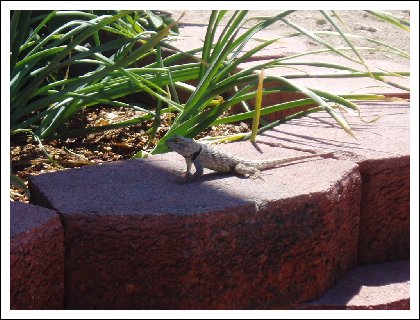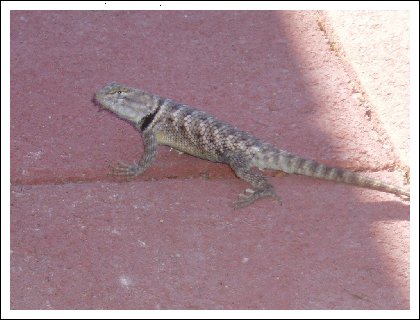Range
The Great Basin Desert from SE Oregon and SW Idaho southward through Nevada and Utah, the Mojave Desert of Nevada, Arizona and California, and the Sonoran Desert of Western Arizona and SE California mainly north of the Gila River.

| The Great Basin Collared Lizard, Crotaphytus bicinctores, is a North American lizard that can be up to 30 cm (one foot) in length, with a large head and powerful jaws. They are well known for the ability to run on their hind legs, looking like small dinosaurs. The name "collared lizard" comes from the lizards' distinct coloration, which includes bands of black around the neck and shoulders that look like a collar. It is a member of the collared lizard family. These animals are possibly best known for their speed. Like the frilled lizard and basilisk, collared lizards can run on their hind legs for long periods of time. Record speeds have been around 56 kph (35 mph). Range The Great Basin Desert from SE Oregon and SW Idaho southward through Nevada and Utah, the Mojave Desert of Nevada, Arizona and California, and the Sonoran Desert of Western Arizona and SE California mainly north of the Gila River. |
 |
 |
Habitat Rocky, hilly terrain and washes and canyons with large rocks used for protection and lookout sites. Habits Collared Lizards are members of the large family Iguanidae and the Subfamily Crotaphytinae which, besides the Collared Lizards, only includes the Leopard Lizards. The family is characterized by small body scales and long, strong hind limbs. The tail does not detach easily and does not grow back as in other lizards of this family. They are one of the few lizards in the desert which are able to run on the two hind legs only. This is known as bipedal locomotion. They are frequently seen on rocks and boulders but are very wary and difficult to catch. From these rocks, they keep a lookout for their favorite prey which is other lizards. They also eat a large variety of invertebrates. Life Cycle Great Basin Collared Lizards mate in May or June and the female lays from 3 to 7 eggs in summer in sandy soils, in burrows or under rocks. There is no parental care after the female lays eggs. |
|
Notes: We have observed this particular lizard for quite some time, as he is a fixture in front of Government House. He is fairly tame, and can be approached to within one meter (three feet). He likes to come out when the plants in front of Government House are being watered, and will generally hang around as long as we do, moving along the pavers to the rocks under the southernmost Russian Olive tree, where a water bowl is kept filled for the benefit of Molossian wildlife. He has the run of the entire front area before Government House, all the way out to the National Flagpole, a distance of several meters which he covers in seconds. We have decided that he most likely lives under one or both of the Dwarf Alberta Spruces in front of Government House, as the dense foliage of these trees makes for good cover and concealment. We estimate him to be about a year old, as he has not reached his full potential size (see above). Observations will continue, us of him and he of us. |
 |